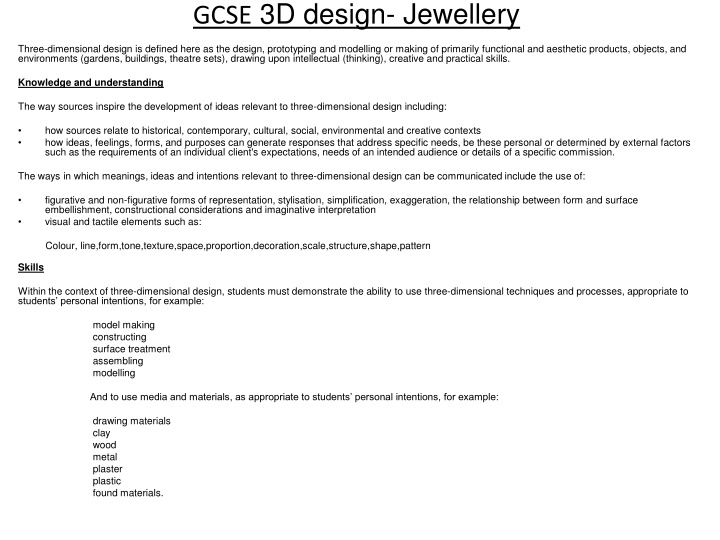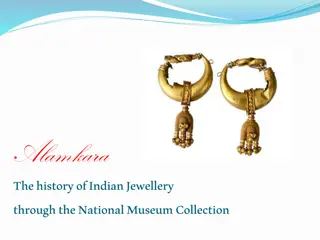GCSE 3D Design - Jewellery Exploration and Creation
Three-dimensional design in the context of jewellery involves designing, prototyping, and making aesthetically pleasing pieces using various materials. Students delve into historical, cultural, and creative influences while honing their skills in model making, construction, and material usage. The coursework emphasizes developing ideas, refining designs, documenting progress, and presenting a personal response.
Download Presentation

Please find below an Image/Link to download the presentation.
The content on the website is provided AS IS for your information and personal use only. It may not be sold, licensed, or shared on other websites without obtaining consent from the author.If you encounter any issues during the download, it is possible that the publisher has removed the file from their server.
You are allowed to download the files provided on this website for personal or commercial use, subject to the condition that they are used lawfully. All files are the property of their respective owners.
The content on the website is provided AS IS for your information and personal use only. It may not be sold, licensed, or shared on other websites without obtaining consent from the author.
E N D
Presentation Transcript
GCSE 3D design- Jewellery Three-dimensional design is defined here as the design, prototyping and modelling or making of primarily functional and aesthetic products, objects, and environments (gardens, buildings, theatre sets), drawing upon intellectual (thinking), creative and practical skills. Knowledge and understanding The way sources inspire the development of ideas relevant to three-dimensional design including: how sources relate to historical, contemporary, cultural, social, environmental and creative contexts how ideas, feelings, forms, and purposes can generate responses that address specific needs, be these personal or determined by external factors such as the requirements of an individual client's expectations, needs of an intended audience or details of a specific commission. The ways in which meanings, ideas and intentions relevant to three-dimensional design can be communicated include the use of: figurative and non-figurative forms of representation, stylisation, simplification, exaggeration, the relationship between form and surface embellishment, constructional considerations and imaginative interpretation visual and tactile elements such as: Colour, line,form,tone,texture,space,proportion,decoration,scale,structure,shape,pattern Skills Within the context of three-dimensional design, students must demonstrate the ability to use three-dimensional techniques and processes, appropriate to students personal intentions, for example: model making constructing surface treatment assembling modelling And to use media and materials, as appropriate to students personal intentions, for example: drawing materials clay wood metal plaster plastic found materials.
GCSE 3D design Controlled assessment AQA ART & DESIGN 3D Jewellery Tatty Divine, Ethnic, Art Deco Artists, designers and craftspeople make jewellery from a variety of materials such as paper, clay, wood, metal, plastic, glass, stone and found materials. Some pieces may have a particular religious, social or personal significance for the wearer. From studies of suitable examples, design and make your own piece of jewellery which will have significance for the wearer. Your coursework will be assessed by the following assessment objectives (AO): AO1. Develop ideas through investigation AO2. Refine work by exploring ideas AO3. Record ideas AO4. Present a personal response
GCSE 3D design Analysis of the brief: What are you required to do? AO1. Develop ideas through investigation Research: Focus of research should be on Materials- paper, clay, wood, metal, plastic, glass, stone and found materials Artists & designers* Processes Use this session to research Jewellery. Use the bullet points above to start the research process. At the end of the lesson you should have the following: 2 x moodboards of the following: A range of examples of jewellery made from the materials and designers listed in the question A range of processes you could use to produce your own jewellery. This could be processes such as: casting with metal (making moulds) , laser cutting with wood & plastic, enamelling, brazing (soldering) using metal such as copper & bronze. Using a lathe to turn wood & metal, cutting and shaping wood using traditional woodworking tools, use of strip heater & vacuum former
3D Design Lesson objectives: 1. 2. 3. 4. 5. New page in book Write the word JEWELLERY Spider diagram of the word jewellery For example: Include thumbnail drawings of jewellery objects such as rings, pendants, bracelets, earrings, necklace. These should be doodles and as such could be the genesis of an idea that can be later expanded. What you are looking to do here is to display creativity. You could include small samples of wood/metal/plastic. Tape or glue them to the page. To help you use the SCAMPER example as a guide to what your page should/could look like + 6. 7.
Artists, designers & design movements Artists & designers- Tatty Divine Design movements- Art Deco Ethnic
3D Design - Jewellery Lesson objectives: To continue design work for jewellery project. Your designs must use a range of materials (plastic, wood, metal) and must include designs for the following: Necklace/pendant Ear rings
3D Design- Jewellery Lesson objectives: To continue design work for jewellery project. Your designs must use a range of materials (plastic, wood, metal) and must include designs for the following: Necklace/pendant Ear rings
3D Design- Jewellery Lesson objectives: To continue design work for jewellery project. Your designs must use a range of materials (plastic, wood, metal) and must include designs for the following: Necklace/pendant Ear rings
Lesson objectives: Task 1 To continue design work for jewellery project. Your designs must use a range of materials (plastic, wood, metal) and must include designs for the following: Necklace/pendant Ear rings Task 2 Start making when your sketch book work has been seen and designs discussed
Evaluation of jewellery project The jewellery project has introduced you to new processes and materials and has allowed you to experiment and play with materials. The structure of the project has introduced you to the format we will use for each project. New projects will allow you to explore in depth the assessment objectives and you will have more time for development of ideas and making. For this project evaluation you are to reflect on how well you responded to: The brief-to design and make jewellery Use of materials-use of a range of materials Use of a range of processes-use of different ways of making Presentation and communication- good communication and drawing skills Made outcomes-creative and well made outcomes
Jewellery project week by week timetable Week 1- Moodboards on Tatty Divine, Art Deco and Ethnic presented in sketch books and annotated-AO1 Week 2 Spider diagram/ mind map examining the question-AO1 Week 3 SCAMPER exercise complete. Coloured and annotated-AO1&2 Week 4- Initial ideas for all 3 design movements- earrings and pendant. Designs to include a range of materials and processes. Pewter casting, laser cutting, Use of 2D design, vaccum former & strip heater-AO 2&3 Week 5- Initial ideas for all 3 design movements- earrings and pendant AO 2&3 Week 6- Begin making- AO 2&3 Week 7- continue making- AO 2&3 Week 8- continue making- AO 2&3 Week 9- continue making and recording your made outcomes-AO2,3&4 Week 10- complete making of jewellery-AO 2&4 Week 11- evaluation of jewellery project. The evaluation should be a reflection on the making of earrings, pendant and any other jewellery items. You should have used a range of processes and materials and experimented with a range of different outcomes-AO3























